
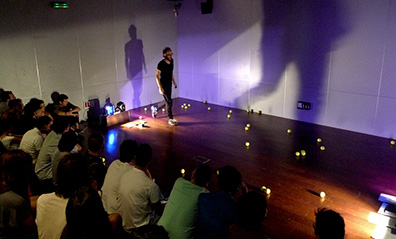
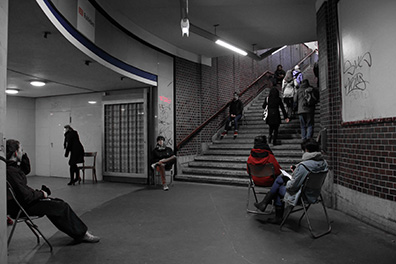
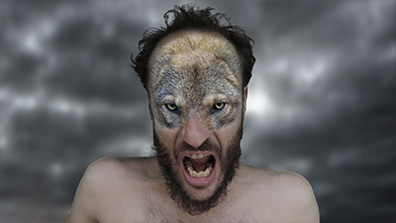
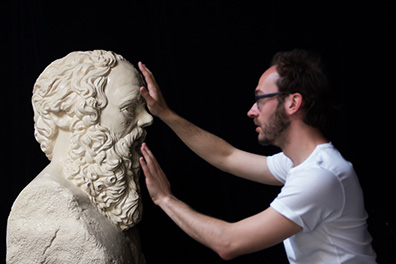
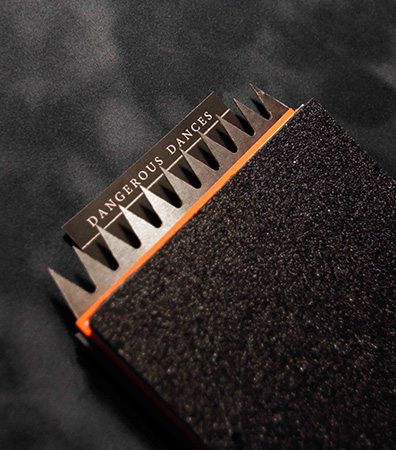
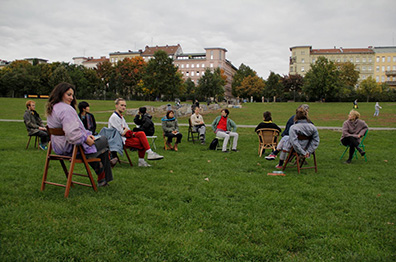
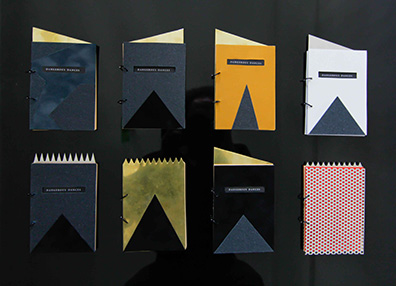
the journey of theory –
dancing the problem
Diego Agulló
Oct 05 – Oct 23, 2015
The role of conceptualization in the artistic practice
During these 3 weeks we will focus on understanding which problems we are dancing to and what are the fundamental problematics that our artistic practices are built upon. This attempt will lead us to reflect together on the relation between theory and practice, philosophy and art, and the role of conceptualization in dance and choreography. How to practice theory? In which way is art a form of theory?
Defining theory as the journey abroad and returning
Our starting point will be to stop understanding theory only as a production of discourse and rather to consider it as an oscillatory movement or, in other words, a journey of traveling abroad and returning. We will translate this journey into the framework of our practices and research in order to trace a trajectory, step by step, distinguishing its different moments and identifying what are the risks that we undertake with our work, what is the level of exposure to danger that we tolerate and to which extent do we allow ourselves to experience uncertainty and ultimately how much are we able to translate this journey into an intelligible form to be shared within the community. This understanding of theory will help to confront the following topics: how to set up the conditions for collaboration between dance and philosophy? What is the need of conceptualizing any choreographic practice? Why is it important for an artist to be able to formulate via concepts what he/she is doing? Why should an artist be busy conceptualizing his/her work?
Dancing the problem
A dance and a concept are both "outcomes" or translations from a common element: a problem. To be able to identify what is your problem as an artist or a researcher is a vital task. To look at how we dance a problem implies to identify the main driving forces motivating our journey, and to observe how our obsessions or needs become the detonator of our artistic research. To define and become aware of these personal obsessions will be one of our challenges: first we will determine what makes us move, what impulses force us to dance a problem. Then we will translate each others´ problems into a series of exercises, which will allow us to experience each others´ practices from tangible physical/performative situations.
Understanding the affinity between our practices and the process of conceptualizing
An art practice shouldn’t be subordinated to the process of conceptualization to avoid the mistake of art serving only to illustrate a concept. Art is a cognitive process of its own right, which does not need validation by any peripheral discourse. At the same time, any art form triggers a discourse and potential further interpretations. With the term conceptualization we will refer to the process of formulating a problem using conceptual maps and flow charts. These cartographies will constitute our tools to better understand the principles of our choreographic practice while training the ability to navigate within the frame of artistic research. This will enable us to articulate linguistically our research, and to formulate our body of work through concepts, making it communicable and intelligible to others. We will become familiar to the etymological approach to concepts using the etymological dictionary as a tool to shake the conventional meanings of a word and to trace the genealogical lineage of a concept.
To explore the intimate affinity between dance and problems
When does dance become a problem? When does a body that is thrown across a space become a difficulty, a puzzle, an astonishing event? The problematic body - the dance that becomes a problem - is the body whose movement generates a problem in space, a movement that implies a difficulty that hits you and puzzles you. How can a dance hit? And hit what? Another body? Or the audience’s perception? A difficult dance is not the dance that is difficult to perform, but the dance that generates difficulties, that becomes an obstacle, that paralyzes you. We will practice dance as the art of generating dilemmas, a turbulence that transforms the space into a puzzle and generates perplexity and occasionally vertigo, turning the situation into a troublesome, turbid, agitated, disordered event. We will practice choreography as the art of throwing invitations to dance, as the activity of transforming situations into dangerous domains of influence. The choreographer brings tempestuous weather on a sunny day.
We will explore if the mission of articulating problems belongs intrinsically to the practice of choreography. To articulate problems implies to throw out difficulties; bodies become puzzles thrown into the distance, a difficulty transforms the scenario into a problematic dance floor. Problems turn the situation into a turbulent event, into a domain of dangerous influences.
––––––––––––––––––––––––––––––––––––––––––––––––––––––––
 Diego Agulló (1980) is a video artist, performer and researcher based in Berlin. He started to think ninja-style when at the age of five he begun to develop a NTL (nothing-to-lose) mindset while playing his favorite game 'Darkness'.
Diego Agulló (1980) is a video artist, performer and researcher based in Berlin. He started to think ninja-style when at the age of five he begun to develop a NTL (nothing-to-lose) mindset while playing his favorite game 'Darkness'.
In 1998, having a background in football and Tae Kwon Do, he decided to study Philosophy for six years at the University in Madrid. During this time he got involved in the practices of music improvisation, sculpture and painting. In 2005, he decided not to open a book for the next three years. He replaced this absence with a video camera and moved to Berlin where he became a VJ. He spent four years working in clubs, experimenting with visuals.
In 2007 he accidentally got involved in performance arts and choreography, and has since been working in the field, mainly in collaboration with Agata Siniarska, Lea Martini and Ibrahim Quaraishi. He has presented work at the 57th Berlinale Filmfestspiele 2007, Oberhausen Short Film Festival, MONA Detroit, Asahi Art Square Tokio, Cinedans, Copenhagen Kunsthalle, Springdance Festival, HAU Berlin, Kampnagel Hamburg, Beursschowburg Brussels, Frascati Amsterdam, Pact Zollverein Essen, Mousonturm Frankfurt, iDans Istanbul, Prague Quadrennial and Dance Theater Workshop New York.
In 2010 he met Dmitry Paranyushkin and they became partners in crime, developing the on-going research project in transitionary states called Transnomia, the mission-based project The Humping Pact and the participatory Kafka-esque event The Waiting Room. Diego is the initiator of the event CUE, which has been internationally active for over 70 editions in the cities of Berlin, Rotterdam, Riga, Madrid, Barcelona, Palermo and Valencia. He is currently co-directing and performing the new show "149.597.871 km" in collaboration with Lea Martini (premiered at Hau 3 in Berlin in December 2012). Diego is also working on a set of short texts that will become a book on the topic of cross-pollination, freelancing and dilettantism. He makes fresh squeezed orange juice every morning and sometimes he forgets to breathe. It's now or never. Day by day.
websites
www.diegoagullo.com
blog
www.it-is-now-or-never-day-by-day.tumblr.com
––––––––––––––––––––––––––––––––––––––––––––––––––––––––
photos:
Diego Agullo
